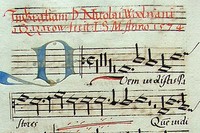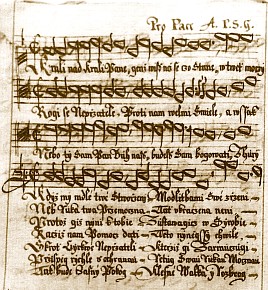
Introduction
In contrast to the Middle Ages‘ mostly anonymous authorship of compositions in Czech graduals, the Czech musical culture of the 16th century presents an array of authors whose names are known. They work predominantly within literary brotherhoods and compose music for liturgical purposes. Their compositions have been preserved in the songbooks of literary brotherhoods along with compositions of famous foreign authors such as Orlando di Lasso, Clemens non Papa, Josquin des Prez etc.Their music varies in style, ranging from strophic polyphonic songs and arrangements of older songs to complex polyphonic compositions that are completely comparable to those of foreign provenience. Unfortunately, only fragments of those songs have been preserved up to the present times
During the Renaissance Kutna Hora was a place of work of several distinguished personalities.
Jan Simonides Montanus
This composer was born in Kutna Hora between the years 1530-1540 and worked here all his life until his death in 1587 [1]. He attained a position of a schoolmaster at the St. Barbara’s Church [3]. He counted among famous Utraquist authors of the times and his works can be found in most of the major sources of Utraquist polyphony of the late 16th century. Today we know 22 of his songs, only one of which has been preserved whole. It is the composition Aurea Luce in the Cesky Krumlov’s song collection. He composed chiefly for literary brotherhoods, namely masses with Latin lyrics and motets, both Czech and Latin. His altogether simple composition technique made a rather archaic impression for that period [2].
Picture of music instruments
(shawm,flute,viol,tabor)
on the St.James school portal
(archdeanery today)
Jan Campanus Vodňaský
This author live between the years 1572-1622. He is especially known as a representative of Latin humanistic poetry and a professor and later the rector of Charles University. Before he left for Prague he had worked as a chief administrator of Kutna Hora’s schools between 1600-1603 [1]. In 1618 he accompanied one collection of his Latin chronometrical poems with music in the style of so called humanistic ode. It is a simple four-voice composition, the rhythm of which imitated the metre of the chronometrical verses. (The most famous of them is probably a two-choir composition Rorando coeli) Compositions of this type were very popular in the scholastic environment around Europe and were supposedly performed at Kutna Hora’s schools, too [2].Pavel Spongopaeus Jistebnický
This author was born between the years 1550-1560 in Jistebnice near Tabor and died in 1619 in Kutna Hora. He worked as a teacher all his life. He took several different posts and in 1598, at the latest, he permanently settled in Kutna Hora, where he worked as an administrator of Kank’s school and also as an elder of the Latin literary choir at St. James‘ Church [4]. He counted among the most prolific Czech composers of his time. Today we known 60 of his compositions. Only the four-voice composition Králi nad králi, Pane (in the Prachatice’s Hymnal) has been preserved whole. As for all the other compositions (extensive six to eight-voice mass cycles), too few voice parts have been preserved in order to get the idea of the character and quality of his music [2].
(in the Prachatice’s Hymnal) has been preserved whole. As for all the other compositions (extensive six to eight-voice mass cycles), too few voice parts have been preserved in order to get the idea of the character and quality of his music [2].
Literature
| [1] | Dačický z Heslova, Mikuláš: Prostopravda, Paměti. Státní nakladatelství krásné literatury, hudby a umění. Praha, 1955. |
| [2] | Horyna, Martin: Hudební skadatelé v renesanční Kutné Hoře. Krásné město. 1/2005. Kutná Hora, 2005. |
| [3] | Horyna, Martin: 22 vícehlasých hymnů z rukopisu Kaplanské knihovny v Českém Krumlově č. 9. 1540-1600. Partitura. Státní vědecká knihovna České Budějovice, 2000. |
| [4] | Státní okresní archív Kutná Hora, fond Archív města Kutná Hora, knihy městské rady (Memorabilia), 1587,1613-1618. |
Links
CANTICA 2006. Contact: kafka@email.cz





